




OUR BEST EVER OFFER - SAVE £100/$100
JOIN THE WORLD'S LEADING PROFESSIONAL DEVELOPMENT PROGRAMME
- 12 months membership of Elite Soccer
- Print copy of Elite Player & Coach Development
- Print copy of The Training Ground
Penetrating or protecting the defensive line
We’re looking for attackers to fashion goalscoring opportunities both when in and out of possession, while defenders must concentrate on defensive compactness, discipline and communication. This resilience is a feature of every successful team, and being able to penetrate this line effectively on a consistent basis is central to winning football matches.
| Area | Up to 86x50 yards |
| Equipment | Balls, cones, flat cones, goals |
| No. of Players | Up to 9v9 plus keepers |
| Session Time | 6v4 plus keeper 4x2mins, 1min rest; Game 4x3mins, 30secs rest |
This session is about penetrating or protecting the defensive line, and is a blueprint that works attackers and defenders in equal measure.
We’re looking for attackers to fashion goalscoring opportunities both when in and out of possession, while defenders must concentrate on defensive compactness, discipline and communication. This resilience is a feature of every successful team, and being able to penetrate this line effectively on a consistent basis is central to winning football matches.
We use this session in the lead-up to every match, with players transitioning in their roles throughout the practice.
What do I get the players to do?
6v4 plus keeper practice
We set up as shown (1), with three target goals across the width, each 1.5 yards wide, and ‘deep’ poles placed at the bottom of the area, which is 35 yards long. Two yards outside the box, a defensive line is marked with flat rubber cones.
1
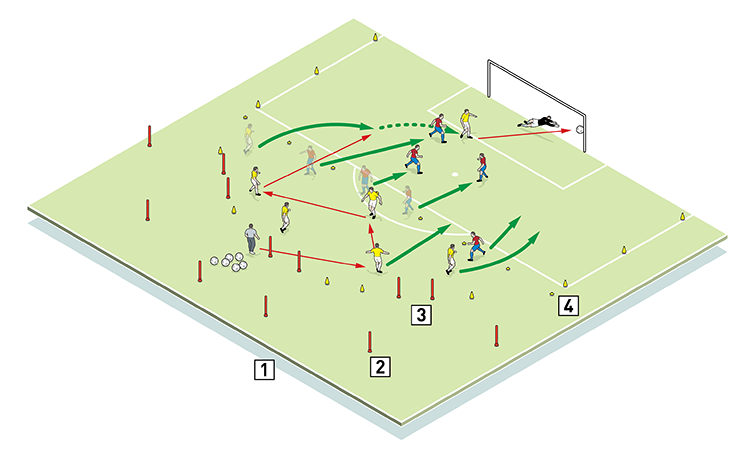
2. Poles
3. Goals
4. Defensive line
The practice requires a keeper and four defenders, who go up against six attackers.
We serve the ball in to the attacking team, who attempt to penetrate the defensive line and score. When the ball goes out of play, defenders must push out past the defensive line as quickly as possible. A new ball is then served in to the attackers.
If defenders win possession, they attempt to pass the ball into a target goal (2a). Scoring offers them a 10-second rest, with each attacker having to run around a deep pole before coming back into the area (2b). These actions replicate instances in a game – the 10-second rest represents defenders making a successful pass out of defence, while attacker movement around the poles mimics recovery runs.
2a
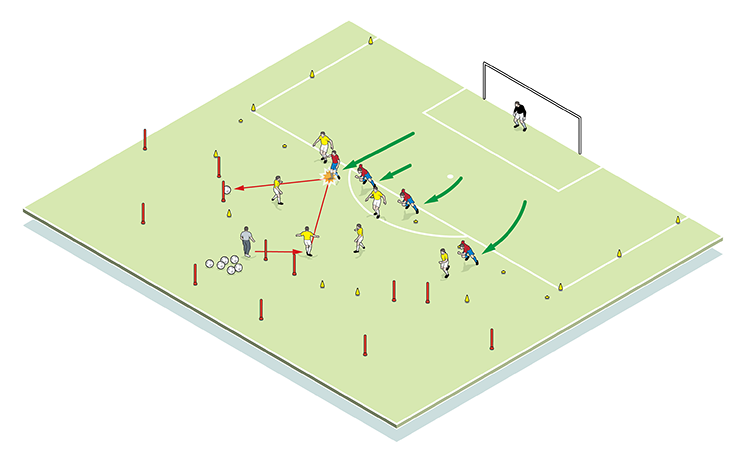
2b
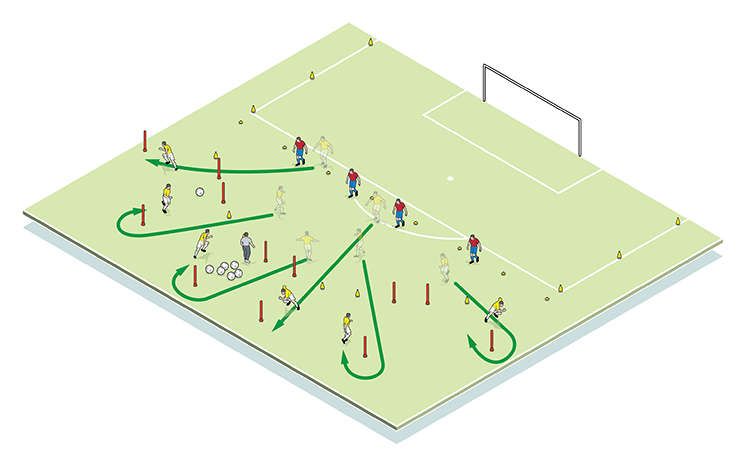
What are the key things to look out for?
We want attackers to disrupt the back four, penetrating the defensive line and executing a positive finish on goal. Within that, connectivity and good decision-making are vital.
Defensively, players must work together, recognising that winning possession is not the end task, but the start of the transition which needs to finish with them scoring in one of the target goals.
We also find it useful to introduce a holding midfield player who plays for the defending team.
How do I put this into a game situation?
Setting up as shown (3a/3b), we create a small-sided game – 9v9 plus keepers in an 86x50-yard area, with two 18-yard end zones. Again, attackers attempt to penetrate the defensive line but can only play one-touch in the end zones. Defenders are not allowed deeper than the defensive line until the ball enters that area.
3a
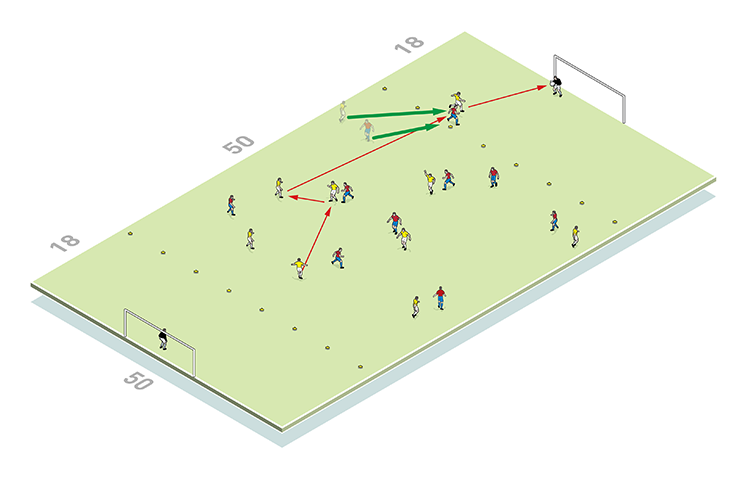
3b
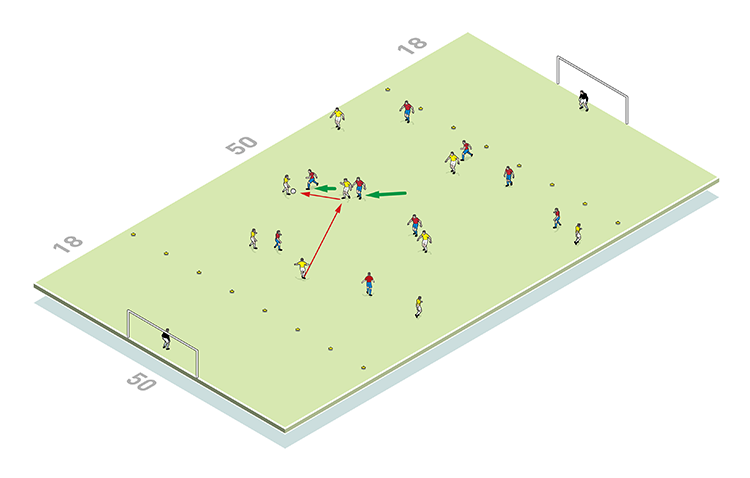
Teams must play at high tempo. Any team that scores regains possession, but missing the target means relinquishing possession.
How do I progress this game?
We can reduce space in order to increase the need for accuracy and speed of thought.
Related Files
Editor's Picks
Attacking transitions
Deep runs in the final third
Using the goalkeeper in build-up play
Intensive boxes drill with goals
Penetrating the final third
Creating and finishing
My philosophy
Pressing initiation
Compact team movement
Coaches' Testimonials

Alan Pardew

Arsène Wenger

Brendan Rodgers

Carlos Carvalhal

José Mourinho

Jürgen Klopp

Pep Guardiola

Roy Hodgson

Sir Alex Ferguson

Steven Gerrard
Coaches' Testimonials

Gerald Kearney, Downtown Las Vegas Soccer Club

Paul Butler, Florida, USA

Rick Shields, Springboro, USA

Tony Green, Pierrefonds Titans, Quebec, Canada
Join the world's leading coaches and managers and discover for yourself one of the best kept secrets in coaching. No other training tool on the planet is written or read by the calibre of names you’ll find in Elite Soccer.
In a recent survey 92% of subscribers said Elite Soccer makes them more confident, 89% said it makes them a more effective coach and 91% said it makes them more inspired.
Get Monthly Inspiration
All the latest techniques and approaches
Since 2010 Elite Soccer has given subscribers exclusive insight into the training ground practices of the world’s best coaches. Published in partnership with the League Managers Association we have unparalleled access to the leading lights in the English leagues, as well as a host of international managers.
Elite Soccer exclusively features sessions written by the coaches themselves. There are no observed sessions and no sessions “in the style of”, just first-hand advice delivered direct to you from the coach.







